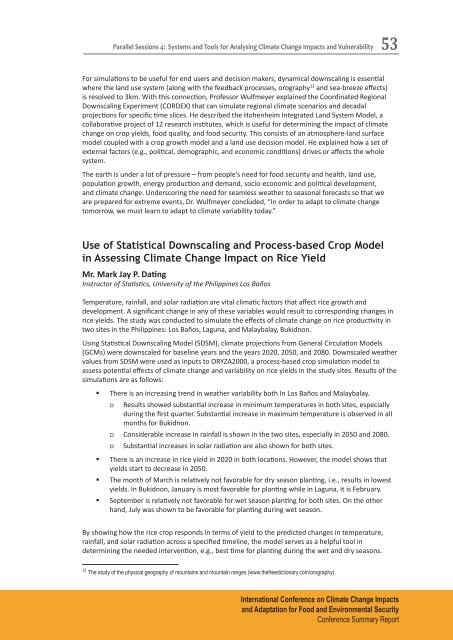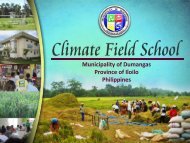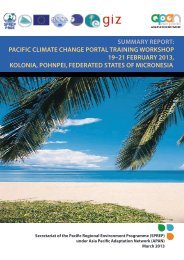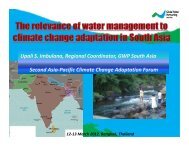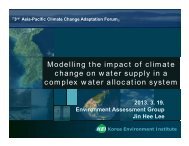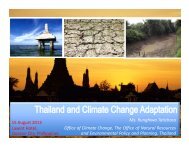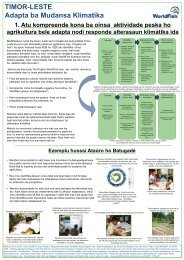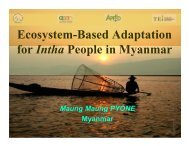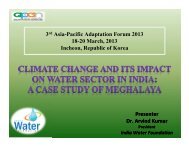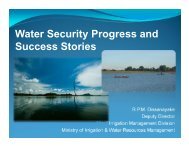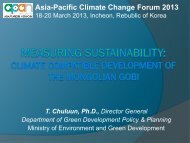PDF file (2.44 MB) - Asia Pacific Adaptation Network
PDF file (2.44 MB) - Asia Pacific Adaptation Network
PDF file (2.44 MB) - Asia Pacific Adaptation Network
You also want an ePaper? Increase the reach of your titles
YUMPU automatically turns print PDFs into web optimized ePapers that Google loves.
Parallel Sessions 4: Systems and Tools for Analysing Climate Change Impacts and Vulnerability53For simulations to be useful for end users and decision makers, dynamical downscaling is essentialwhere the land use system (along with the feedback processes, orography 12 and sea-breeze effects)is resolved to 3km. With this connection, Professor Wulfmeyer explained the Coordinated RegionalDownscaling Experiment (CORDEX) that can simulate regional climate scenarios and decadalprojections for specific time slices. He described the Hohenheim Integrated Land System Model, acollaborative project of 12 research institutes, which is useful for determining the impact of climatechange on crop yields, food quality, and food security. This consists of an atmosphere-land surfacemodel coupled with a crop growth model and a land use decision model. He explained how a set ofexternal factors (e.g., political, demographic, and economic conditions) drives or affects the wholesystem.The earth is under a lot of pressure – from people’s need for food security and health, land use,population growth, energy production and demand, socio-economic and political development,and climate change. Underscoring the need for seamless weather to seasonal forecasts so that weare prepared for extreme events, Dr. Wulfmeyer concluded, “In order to adapt to climate changetomorrow, we must learn to adapt to climate variability today.”Use of Statistical Downscaling and Process-based Crop Modelin Assessing Climate Change Impact on Rice YieldMr. Mark Jay P. DatingInstructor of Statistics, University of the Philippines Los BañosTemperature, rainfall, and solar radiation are vital climatic factors that affect rice growth anddevelopment. A significant change in any of these variables would result to corresponding changes inrice yields. The study was conducted to simulate the effects of climate change on rice productivity intwo sites in the Philippines: Los Baños, Laguna, and Malaybalay, Bukidnon.Using Statistical Downscaling Model (SDSM), climate projections from General Circulation Models(GCMs) were downscaled for baseline years and the years 2020, 2050, and 2080. Downscaled weathervalues from SDSM were used as inputs to ORYZA2000, a process-based crop simulation model toassess potential effects of climate change and variability on rice yields in the study sites. Results of thesimulations are as follows:• There is an increasing trend in weather variability both In Los Baños and Malaybalay.o Results showed substantial increase in minimum temperatures in both sites, especiallyduring the first quarter. Substantial increase in maximum temperature is observed in allmonths for Bukidnon.o Considerable increase in rainfall is shown in the two sites, especially in 2050 and 2080.o Substantial increases in solar radiation are also shown for both sites.• There is an increase in rice yield in 2020 in both locations. However, the model shows thatyields start to decrease in 2050.• The month of March is relatively not favorable for dry season planting, i.e., results in lowestyields. In Bukidnon, January is most favorable for planting while in Laguna, it is February.• September is relatively not favorable for wet season planting for both sites. On the otherhand, July was shown to be favorable for planting during wet season.By showing how the rice crop responds in terms of yield to the predicted changes in temperature,rainfall, and solar radiation across a specified timeline, the model serves as a helpful tool indetermining the needed intervention, e.g., best time for planting during the wet and dry seasons.12The study of the physical geography of mountains and mountain ranges (www.thefreedictionary.com/orography).International Conference on Climate Change Impactsand <strong>Adaptation</strong> for Food and Environmental SecurityConference Summary Report


